
Magnolia Trees: Care and Recommendation
Published: 17/07/2024 | Updated: 17/07/2024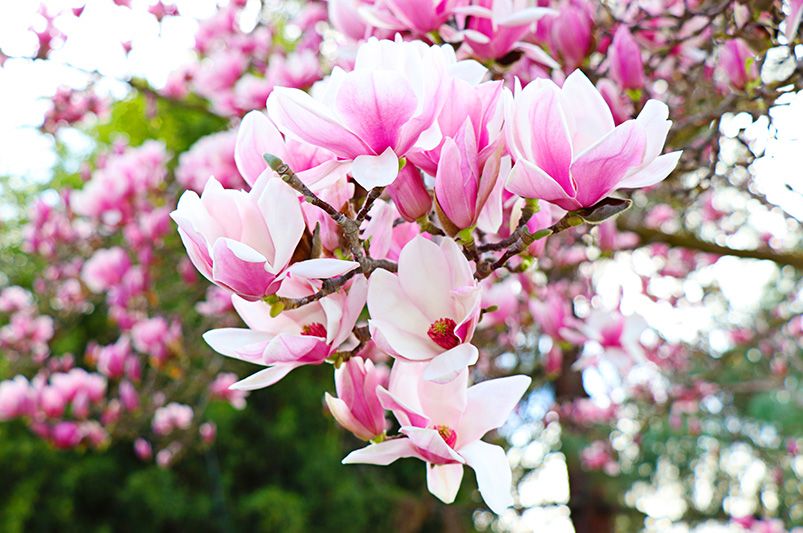
The scenic beauty and elegance of Magnolia trees and shrubs are to thank for the trees' consistent popularity for ornamental uses in landscapes. With stunning large blossoms that come in various colors, including shades of white, pink, and purple, these flowering trees create a display that is impossible to look away from. In this guide, we will walk you through what it takes to plant magnolia trees and take sufficient care of them to have them thrive in your landscape before we delve into our favorite Magnolia trees of all time.


Check out our weekly blog here. We cover everything related to landscapes, including pro tips, recommendations, and more guides.
Everything You Need to Know About Magnolia Trees
Magnolia trees (Magnolias) belong to the genus Magnolia and are native to various regions worldwide, including North and South America, East Asia, and the Himalayas. The over 200 species that make up this genus are natively distributed over those regions, with varieties in climate-related requirements among them.
There are both evergreen Magnolias and deciduous Magnolias. Deciduous trees and shrubs usually grow in cool temperatures, while their evergreen counterparts live in warmer regions. Varieties in the colors of Magnolia flowers are also striking, ranging from white flowers to shades of pink and purple.
Ideal Conditions and Care Requirements
Here, we'll break down the conditions Magnolia Trees require to grow and the care and regular maintenance you'd be expected to provide for their health and longevity.
Climate Preferences and Hardiness Zones
Magnolia trees can tolerate a range of temperatures, from cold climates (e.g., Zone 4) for specific species, such as Saucer Magnolia, to warm climates (e.g., Zone 9) for species like Southern Magnolia. Ensure you choose a magnolia species suitable for your climate.
Sunlight Exposure Preferences
Most magnolia species prefer full sun to partial shade, though some can tolerate more shade. Magnolia trees bloom best when provided with at least 6 hours of direct sunlight per day.
Soil Conditions
Magnolia trees and shrubs prefer loose, breathable, well drained soil with even moisture. Soil type doesn't matter as long as it's well draining. If you soil type isn't well draining, like heavy clay soils for example, you can fix it with organic matter. Just make sure to do so before you transfer you Magnolia tree.
Watering
Newly planted magnolia trees require regular watering to establish a strong root system. Water deeply once or twice a week, providing about an inch of water each time. Once the tree is established, the frequency of watering will be reduced. Magnolia trees are moderately drought-tolerant once established, but it's still important to provide supplemental irrigation during extended dry periods.
Mulching
Apply a layer of organic mulch around the base of the tree, extending it to the drip line. This helps conserve moisture, suppress weeds, and regulate soil temperature. Maintain a mulch layer that is 2-4 inches deep, and ensure that it is not piled against the trunk to prevent rot.
Pruning
Pruning is beneficial to Magnolias. It helps keep the desired shape and size and keeps the trees healthy. Remove any dead, diseased, or damaged branches by making clean cuts just outside the branch collar. Avoid excessive pruning, as magnolia trees have limited ability to recover from large cuts. Prune in late winter or early spring before new growth begins.
Fertilizing
Fertilize magnolia trees in early spring before new growth starts. Use a slow-release, balanced fertilizer specifically formulated for trees and shrubs. That shouldn't be a replacement for a rich soil amended with organic matter and compost.
Frost Protection
Some magnolia species, particularly those with early spring blooms, may be vulnerable to late frosts. Consider planting them in a sheltered location or using protective measures, such as covering the tree overnight during frosty periods.
8 Magnolias To Grow
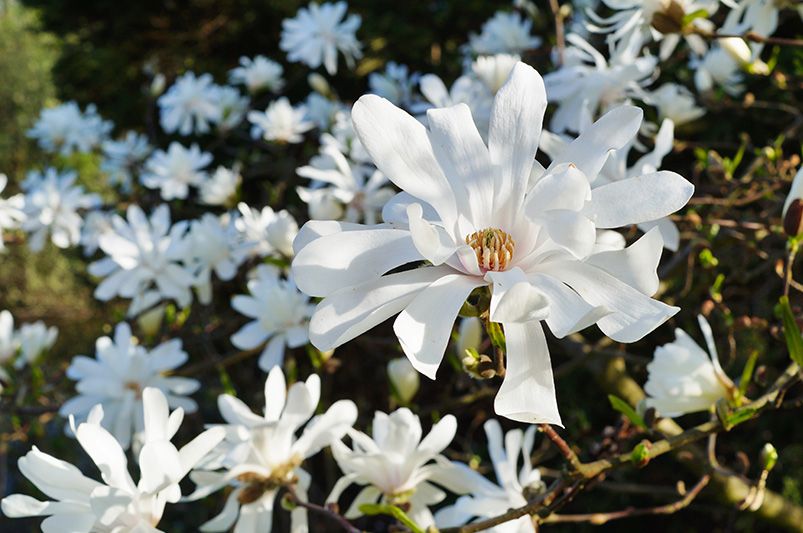
Royal Star Magnolia
The Royal Star Magnolia (Magnolia stellata 'Royal Star') is a captivating deciduous shrub or small tree that's known for its compact form and multiple stems growth habit. Its maximum size is between 10 and 15 feet tall with slightly smaller spread.
This delightful flowering tree features large, star-shaped pure white flowers, with a hint of pink that appear early in the spring. The Royal Star Magnolia is favored for its exceptional hardiness, with the ability to withstand colder temperatures than other Magnolia trees. It grows best in USDA hardiness zones 4-9. This beauty adds so much elegance to gardens and landscapes.
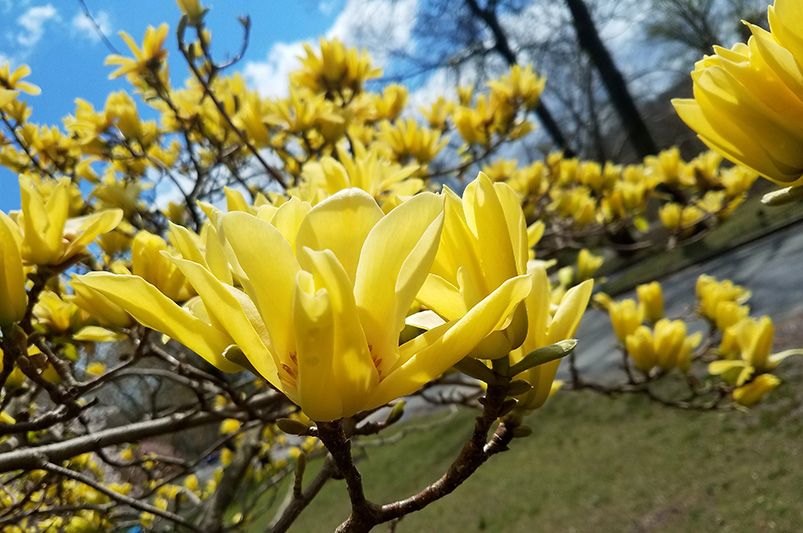
Magnolia Butterflies
Magnolia Butterflies is a stunning hybrid cultivar. Its golden-yellow flowers bloom in the shape of butterflies, earning it its name. They bloom pretty early in the spring, often even before the leaves emerge. This deciduous magnolia grows well in USDA hardiness zones 4-9.
The tree has an upright and compact habit and can reach a height of 15-20 feet. This doesn't make it exactly a shade tree, but it's very suitable for smaller gardens or as a focal point in larger landscapes.
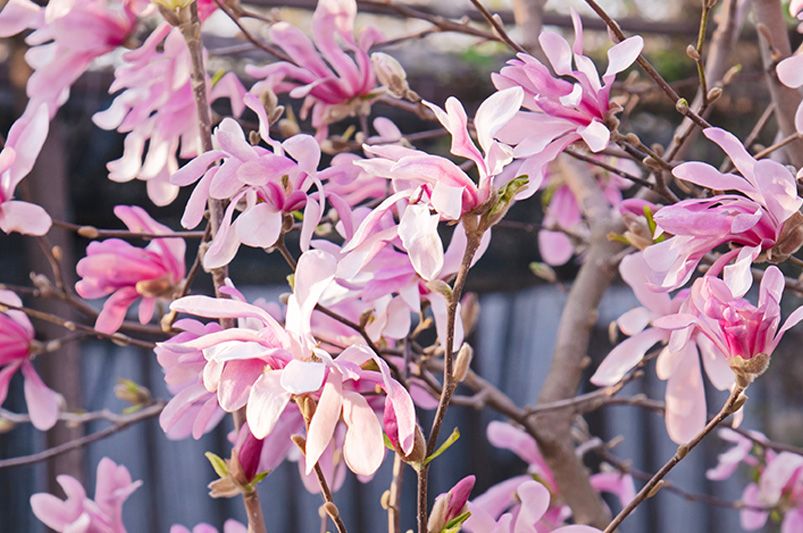
Leonard Messel Magnolia
Leonard Messel Magnolia (Magnolia x loebneri 'Leonard Messel') is one of the most exciting hybrid varieties. It has a significant profusion of star-shaped, fragrant pink flowers that appear in early spring. This hybrid magnolia variety is a cross between Kobus magnolia and Stellata Magnolia, both renowned for their flowers.
The petals are soft pink, sometimes with a hint of purple, and emit a sweet fragrance that attracts pollinators. The Leonard Messel Magnolia can reach a height of around 15-20 feet and is well-suited to gardens of any size. They grow well in USDA hardiness zones 5 to 9.
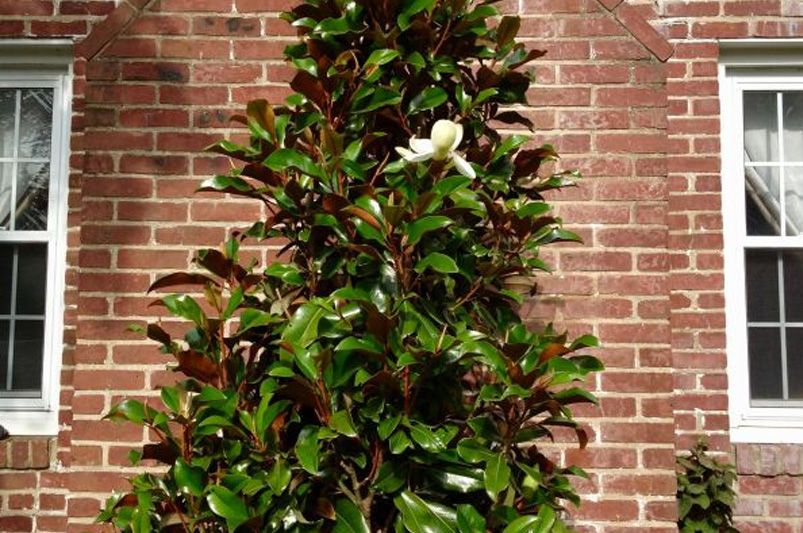
Kay Parris Magnolia Tree
Kay Parris Magnolia Tree (Magnolia grandiflora 'Kay Parris') is a beautiful evergreen Magnolia cultivar. It blooms with glorious, fragrant, cup-shaped white flowers against glossy, dark green foliage. This large evergreen tree grows with a pyramidal habit to reach 30 feet tall and 20 feet wide.
The tree blooms from late spring to early summer, attracting pollinators. It grows well in zones 6 to 9. Additionally, the Kay Parris Magnolia has a high disease tolerance and is adaptable to different soil and light conditions.
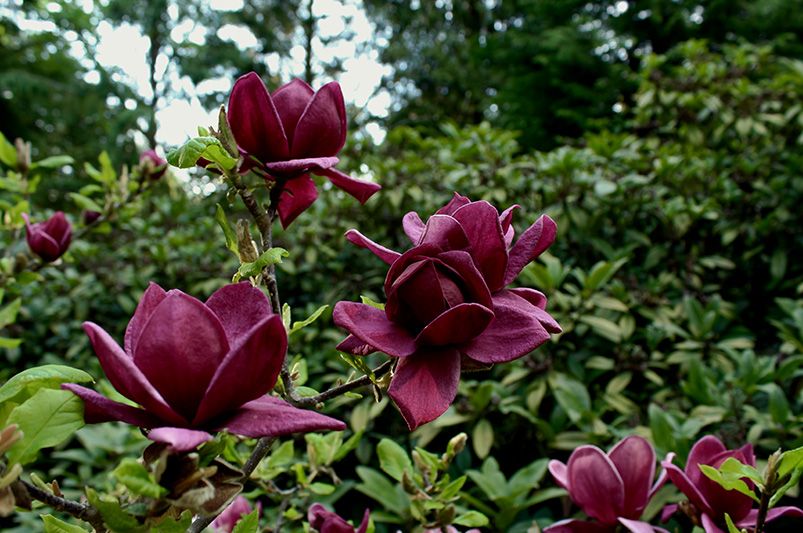
Genie Magnolia Tree
Genie Magnolia Tree (Magnolia 'Genie') is a beautiful hybrid that's prized for its tulip-shaped, burgundy flowers. The deep purple-red flowers emerge in early spring, creating a dramatic spectacle. It thrives in hardiness zones 5-9, where it grows as a deciduous tree.
The 'Genie' cultivar is also recognized for its compact growth habit, making it an excellent choice for smaller gardens or as a striking focal point in larger landscapes. When mature, it reaches a height of 10 to 13 feet tall and 5 feet wide.
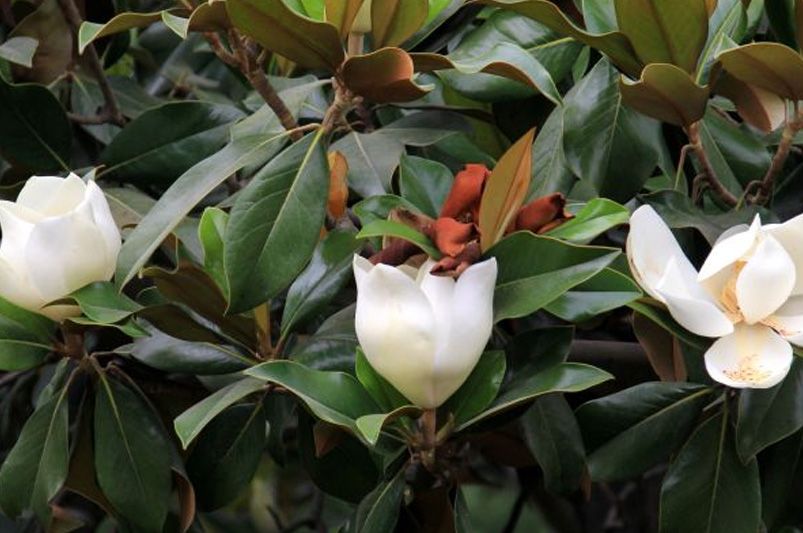
D.D. Blanchard Southern Magnolia Tree
D.D Blanchard Southern Magnolia Tree (Magnolia grandiflora 'D.D Blanchard') is a magnificent evergreen cultivar whose foliage emerges in glossy, leathery, dark green leaves that shines when contrasted with the showy white flowers. It blooms from late spring to early summer.
This large evergreen tree has a dense, pyramidal growth habit and can reach a height of 50-60 feet with a spread of 30-40 feet, making it a perfect shade tree in any landscape. This Southern Magnolia cultivar thrives in full sun to partial shade and is adaptable to various soil types. It's a resilient tree that thrives best in 7-9 zones.
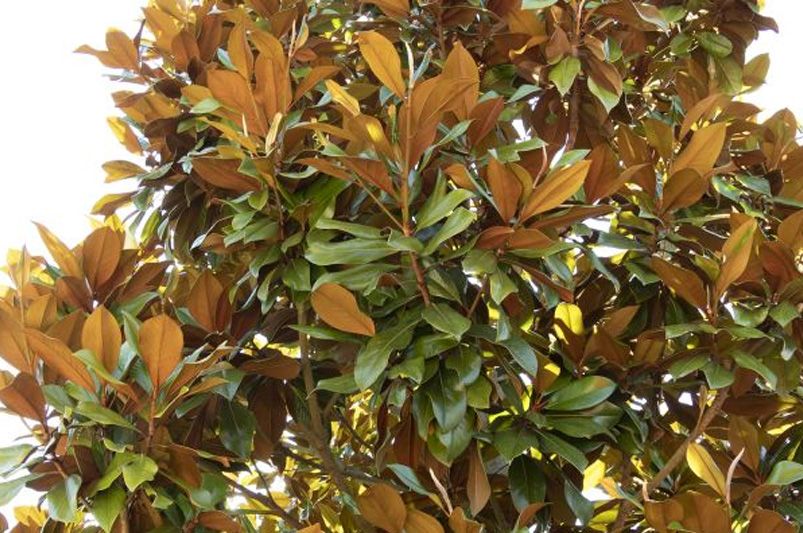
Bracken Brown Magnolia Tree
The Bracken Brown Magnolia Tree (Magnolia x brackenbrownii) is another highly valued hybrid variety. Those Magnolia trees also bloom in tulip-shaped flowers in the reddish-purple color, which creates an eye-catching display in early spring. This hybrid magnolia showcases a spreading, multi-stemmed growth habit, reaching a height of 15-20 feet and a similar spread.
The Bracken Brown Magnolia is a hardy tree that can thrive in various soil types and is more tolerant of colder temperatures compared to other magnolia varieties. Its ability to bloom early in the spring makes it a standout tree in colder regions. It's a perfect tree for hardiness zones 5-9.
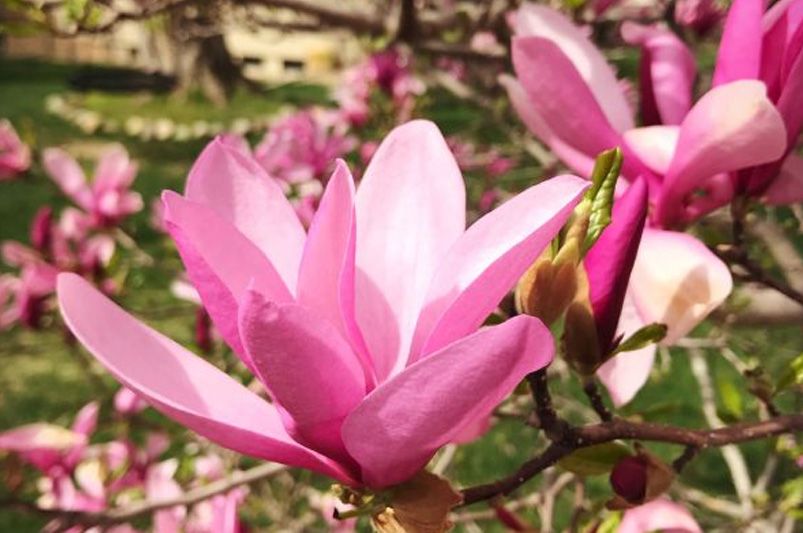
Betty Magnolia Tree
Betty Magnolia is a charming hybrid from a cross between the lovely Magnolia liliiflora and Magnolia stellata. It features large, tulip-shaped pink flowers whose fragrance lingers in the garden for a long period of time. Its mature size is between 10-15 feet tall and has a similar spread.
The Betty Magnolia is known for its hardiness and compact growth habit, making it a lovely addition to smaller gardens or as a striking focal point in larger landscapes. It thrives in hardiness zones 3-8, notably more cold hardy than most Magnolias, while also having a striking ability to tolerate the warmer climate of the south.
Remember to consider the specific care requirements of the magnolia species you have, as they may have slight variations in their needs. Carefully follow the care instructions provided for you in this guide as it will help you ensure healthy growth and abundant flowering in the Magnolia trees you choose for your landscape.
Purchase your favorite Magnolia from our Shrubhub shop. You get free shipping if you order for over $129.
Make sure that your landscape design is up to date. If it's not, then you're here at the right time! We're currently offering a 70% discount on all our landscape design services, including 3D and 2D designs. Sign up here, and you'll be contacted as soon as possible for your personalized design.


